-
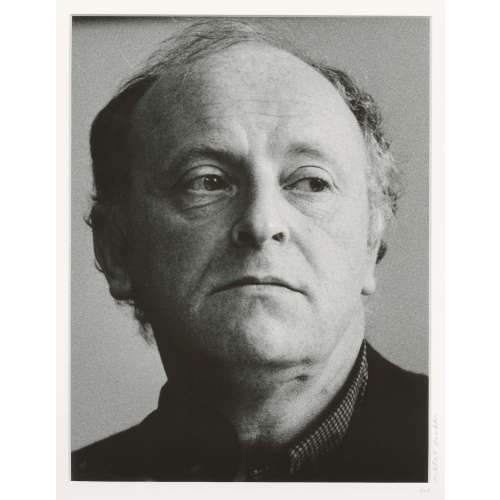 Photographic portrait of poet Joseph Brodsky, head and shoulder, turned slightly right, looking to the right. Pencil-signed on the mat: 1/45 • Mikhail Lemkhin; same inscription on the back of the print, and ink stamp ©Mikhail Lemkhin. Sitter: Joseph Brodsky [Иосиф Александрович Бродский ] (Russian-American-Jewish, 1940 – 1996). Size: mat: 51 x 40.5 cm; window: 34.5 x 27 cm; print: 35 x 28 cm.
Photographic portrait of poet Joseph Brodsky, head and shoulder, turned slightly right, looking to the right. Pencil-signed on the mat: 1/45 • Mikhail Lemkhin; same inscription on the back of the print, and ink stamp ©Mikhail Lemkhin. Sitter: Joseph Brodsky [Иосиф Александрович Бродский ] (Russian-American-Jewish, 1940 – 1996). Size: mat: 51 x 40.5 cm; window: 34.5 x 27 cm; print: 35 x 28 cm. -
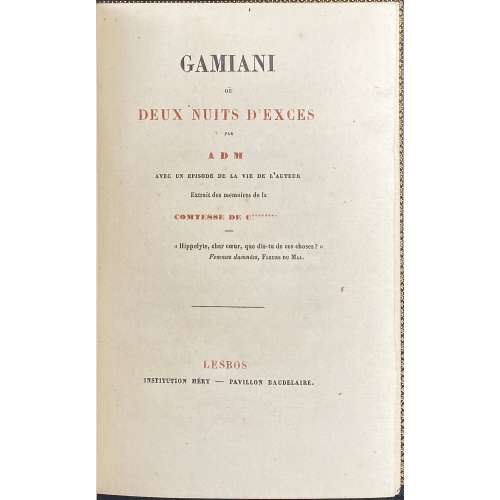 Single volume, 16.8 x 11.3 cm, bound in full dark olive crushed morocco by Brany (signed), gilt triple-fillet border to boards, spine with raised bands, gilt in compartments, gilt-lettered label, gilt dentelle inside, marbled endpapers, all margins gilt, gilt double fillet to boards margin; text printed on laid paper. Bookplate of Maurice Lebarbier de Tinan to fep 45 x 35 mm representing standing satyr with erected penis holding monogram ‘MT’ in his hands with a motto below on a ribbon ‘FAIRE SANS DIRE’. Maurice Lebarbier de Tinan book collection was dispersed via l’hôtel Drouot (Paris) on a sale from March 9 to 12, 1885; a catalogue was published: Catalogue d’un joli choix de livres anciens et modernes, en très belle condition de reliure, composant la bibliothèque de M. L. de T*** [Lebarbier de Tinan] (Paris, Ch. Porquet, 1885, in-8, VIII-140 p., 481 lots). Collation: π2 (h.t., t.p.) a6 b2 1-1112, total 82 leaves plus 18 engraved plates on wove paper; illustrations include engraved frontispiece and six etchings printed in two versions each, black and red, and one etching (at p. 103) in two states, two colour versions for each state, frontispiece and 3 or 4 plates after Félicien Rops, the others after original lithographs by Devéria and Henri Grévedon or Octave Tassaert for the 1833 edition (re-print of 1926 LIB-3135.2023). Pagination: [4] [i] ii-xvi, [3] 4-141 [3], total 164 pages, ils. Title-page (red and black): GAMIANI | OU | DEUX NUITS D’EXCES | PAR | A D M | AVEC UN EPISODE DE LA VIE DE L’AUTEUR | Extrait des mémoires de la | COMTESSE DE C******** | – | « Hippolyte, cher cœur, que dis-tu ces choses ? » | Femmes damnées, Fleurs du Mal. | — | LESBOS | INSTITUTION MERY — PAVILLON BAUDELAIRE. || Catalogue raisonné: Dutel I: A-464; Bory: 596-605; Pia: 516/7. According to Pia, the print run is limited to 150 copies on laid paper. Ref.: BNF Enfer 419. Fekete (Christie's): 135. Provenance: Maurice Lebarbier de Tinan (French, 1842 – 1918). Contributors: Alfred de Musset (French, 1810 – 1857) – author. Félicien Rops (Belgian, 1833 – 1898) – artist. Auguste Poulet-Malassis (French, 1825 – 1878) – publisher. Catalogue Poulet-Malassis & ses amis description: № 5. [Alfred de MUSSET] A D M. Gamiani ou Deux nuits d’excès, avec un épisode de la vie de l’auteur, extrait des mémoires de la comtesse de C********. Lesbos, Institution Méry, Pavillon Baudelaire [A. Poulet-Malassis, 1864]. Illustré de 8 gravures, dont l’une en frontispice, en double état (et quatre états pour la gravure « au singe » de la page 103) de Félicien Rops. Là où Baudelaire soutient Poulet-Malassis quand l’éditeur soutient l’attribution à Musset. Perfectionniste ? Trop cher ? Trop sollicité ? Pas toujours inspiré ? Rops réalisera rarement des suites complètes, ne répondant le plus souvent à la demande de ses commanditaires que par la conception de frontispices. Au verso du faux-titre, Launay voit une justification de 150 exemplaires sur papier vergé, paraphés et numérotés, qui ne figure pas ici. Très bel exemplaire relié par Brany. Provenance : Bibliothèque de Lebarbier de Tinan de Lebarbier de Tinan dont la collection fut dispersée en 1885, justifié par son ex-libris représentant un satyre en érection, portant la devise “Faire sans dire”. Bibliographie : Pia 558, Per 16-8, PC 1299, Lau 285, Enfer 419, Dutel A-464." [LIB-3118.2022]
Single volume, 16.8 x 11.3 cm, bound in full dark olive crushed morocco by Brany (signed), gilt triple-fillet border to boards, spine with raised bands, gilt in compartments, gilt-lettered label, gilt dentelle inside, marbled endpapers, all margins gilt, gilt double fillet to boards margin; text printed on laid paper. Bookplate of Maurice Lebarbier de Tinan to fep 45 x 35 mm representing standing satyr with erected penis holding monogram ‘MT’ in his hands with a motto below on a ribbon ‘FAIRE SANS DIRE’. Maurice Lebarbier de Tinan book collection was dispersed via l’hôtel Drouot (Paris) on a sale from March 9 to 12, 1885; a catalogue was published: Catalogue d’un joli choix de livres anciens et modernes, en très belle condition de reliure, composant la bibliothèque de M. L. de T*** [Lebarbier de Tinan] (Paris, Ch. Porquet, 1885, in-8, VIII-140 p., 481 lots). Collation: π2 (h.t., t.p.) a6 b2 1-1112, total 82 leaves plus 18 engraved plates on wove paper; illustrations include engraved frontispiece and six etchings printed in two versions each, black and red, and one etching (at p. 103) in two states, two colour versions for each state, frontispiece and 3 or 4 plates after Félicien Rops, the others after original lithographs by Devéria and Henri Grévedon or Octave Tassaert for the 1833 edition (re-print of 1926 LIB-3135.2023). Pagination: [4] [i] ii-xvi, [3] 4-141 [3], total 164 pages, ils. Title-page (red and black): GAMIANI | OU | DEUX NUITS D’EXCES | PAR | A D M | AVEC UN EPISODE DE LA VIE DE L’AUTEUR | Extrait des mémoires de la | COMTESSE DE C******** | – | « Hippolyte, cher cœur, que dis-tu ces choses ? » | Femmes damnées, Fleurs du Mal. | — | LESBOS | INSTITUTION MERY — PAVILLON BAUDELAIRE. || Catalogue raisonné: Dutel I: A-464; Bory: 596-605; Pia: 516/7. According to Pia, the print run is limited to 150 copies on laid paper. Ref.: BNF Enfer 419. Fekete (Christie's): 135. Provenance: Maurice Lebarbier de Tinan (French, 1842 – 1918). Contributors: Alfred de Musset (French, 1810 – 1857) – author. Félicien Rops (Belgian, 1833 – 1898) – artist. Auguste Poulet-Malassis (French, 1825 – 1878) – publisher. Catalogue Poulet-Malassis & ses amis description: № 5. [Alfred de MUSSET] A D M. Gamiani ou Deux nuits d’excès, avec un épisode de la vie de l’auteur, extrait des mémoires de la comtesse de C********. Lesbos, Institution Méry, Pavillon Baudelaire [A. Poulet-Malassis, 1864]. Illustré de 8 gravures, dont l’une en frontispice, en double état (et quatre états pour la gravure « au singe » de la page 103) de Félicien Rops. Là où Baudelaire soutient Poulet-Malassis quand l’éditeur soutient l’attribution à Musset. Perfectionniste ? Trop cher ? Trop sollicité ? Pas toujours inspiré ? Rops réalisera rarement des suites complètes, ne répondant le plus souvent à la demande de ses commanditaires que par la conception de frontispices. Au verso du faux-titre, Launay voit une justification de 150 exemplaires sur papier vergé, paraphés et numérotés, qui ne figure pas ici. Très bel exemplaire relié par Brany. Provenance : Bibliothèque de Lebarbier de Tinan de Lebarbier de Tinan dont la collection fut dispersée en 1885, justifié par son ex-libris représentant un satyre en érection, portant la devise “Faire sans dire”. Bibliographie : Pia 558, Per 16-8, PC 1299, Lau 285, Enfer 419, Dutel A-464." [LIB-3118.2022] -
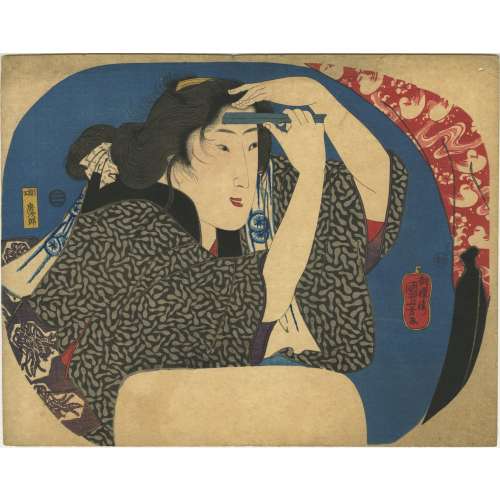 Artist: Utagawa Kuniyoshi [歌川 國芳] (Japanese, 1798 – 1861). Publisher: Ibaya Senzaburō [伊場屋仙三郎] (Japanese, fl. C. 1845 – 1847), seal: San [三] (Marks 11-001 | 127c). Carver: Matsushima Fusajirō [松嶋房次郎] (Japanese, fl. 1843 – 1850); seal [彫工房次郎] – Hori kō Fusajirō (Gordon Friese № 136) Signed: Chōōrō Kuniyoshi ga [朝櫻楼国芳画] in a red double gourd-shaped cartouche. Nanushi censor seal: Tanaka [田中]; V/1844 or II/1845. Media: Fan print (uchiwa-e, 団扇絵), 238 x 304 mm. Reference: Kuniyoshi Project. Series mentioned in Robert Schaap. Heroes and ghosts: Japanese prints by Kuniyoshi, 1797-1861.— Leiden: Hotei Publishing, 1998; p. 122 [LIB-1030.2016].
Artist: Utagawa Kuniyoshi [歌川 國芳] (Japanese, 1798 – 1861). Publisher: Ibaya Senzaburō [伊場屋仙三郎] (Japanese, fl. C. 1845 – 1847), seal: San [三] (Marks 11-001 | 127c). Carver: Matsushima Fusajirō [松嶋房次郎] (Japanese, fl. 1843 – 1850); seal [彫工房次郎] – Hori kō Fusajirō (Gordon Friese № 136) Signed: Chōōrō Kuniyoshi ga [朝櫻楼国芳画] in a red double gourd-shaped cartouche. Nanushi censor seal: Tanaka [田中]; V/1844 or II/1845. Media: Fan print (uchiwa-e, 団扇絵), 238 x 304 mm. Reference: Kuniyoshi Project. Series mentioned in Robert Schaap. Heroes and ghosts: Japanese prints by Kuniyoshi, 1797-1861.— Leiden: Hotei Publishing, 1998; p. 122 [LIB-1030.2016].
-
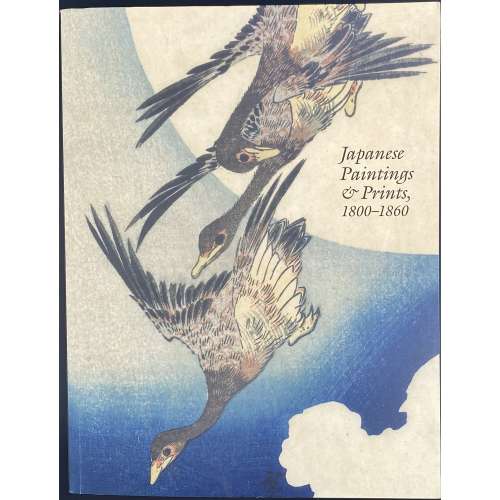 Softcover, in pictorial wrappers, 28 x 21.7 cm, 70 entries, with colour illustrations. Catalogue of the sales exhibition on March 17-24, 2023 in NY; pagination: [1-3] 4-142 [2], ils. Invitation card laid in. Contributor: Sebastian Izzard
Softcover, in pictorial wrappers, 28 x 21.7 cm, 70 entries, with colour illustrations. Catalogue of the sales exhibition on March 17-24, 2023 in NY; pagination: [1-3] 4-142 [2], ils. Invitation card laid in. Contributor: Sebastian Izzard -
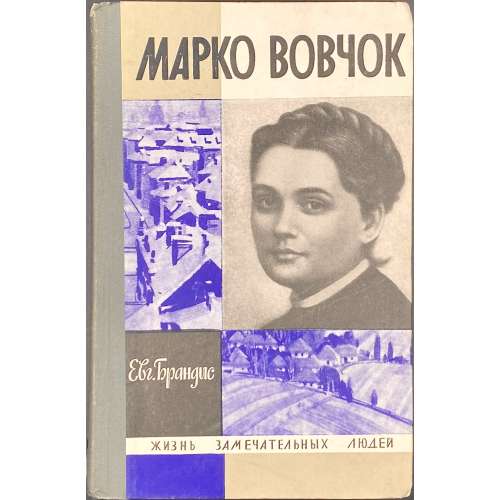 Hardcover volume, 20.8 x 13.5 cm, pictorial paper backed with grey cloth, black and white lettering to spine (serial design), pp.: [1-4] 5-333 [3]; collated 8vo: 1-218; total 168 leaves plus 13 photomechanical plates. Title-page (blue and black): Евг. Брандис | МАРКО ВОВЧОК | ИЗДАТЕЛЬСТВО | ЦК ВЛКСМ | «МОЛОДАЯ ГВАРДИЯ» | — || Frontispiece (blue and black): ЖИЗНЬ | ЗАМЕЧАТЕЛЬНЫХ | ЛЮДЕЙ | Серия биографий | ОСНОВАНА | В 1933 ГОДУ | М. ГОРЬКИМ | ВЫПУСК 19 / 460 {torch} МОСКВА / 1968 || Print-run: 100,000 copies. Contributors: Евгений Павлович Бра́ндис (Russian, 1916 – 1985) – author. Марко Вовчок [Марія Олександрівна Вілінська, Marko Vovtchok] (Ukrainian, 1833 – 1907) – character. Борис Борисович Лобач-Жученко (Russian, 1899 – 1995) – dedicatee.
Hardcover volume, 20.8 x 13.5 cm, pictorial paper backed with grey cloth, black and white lettering to spine (serial design), pp.: [1-4] 5-333 [3]; collated 8vo: 1-218; total 168 leaves plus 13 photomechanical plates. Title-page (blue and black): Евг. Брандис | МАРКО ВОВЧОК | ИЗДАТЕЛЬСТВО | ЦК ВЛКСМ | «МОЛОДАЯ ГВАРДИЯ» | — || Frontispiece (blue and black): ЖИЗНЬ | ЗАМЕЧАТЕЛЬНЫХ | ЛЮДЕЙ | Серия биографий | ОСНОВАНА | В 1933 ГОДУ | М. ГОРЬКИМ | ВЫПУСК 19 / 460 {torch} МОСКВА / 1968 || Print-run: 100,000 copies. Contributors: Евгений Павлович Бра́ндис (Russian, 1916 – 1985) – author. Марко Вовчок [Марія Олександрівна Вілінська, Marko Vovtchok] (Ukrainian, 1833 – 1907) – character. Борис Борисович Лобач-Жученко (Russian, 1899 – 1995) – dedicatee. -
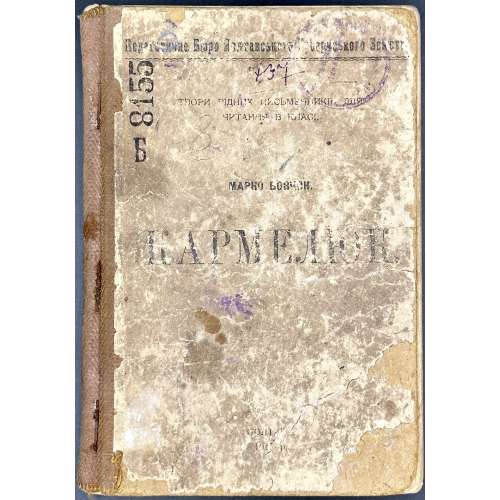 Owner’s quarter brown cloth, 18.2 x 12.5 cm, lettered paper over cardboard; text printed on tan paper, [1, 2] (t.p.), [i] ii-viii (intro.), [1] 4-48 (text); total 28 leaves; blue and red crayon marks to text; boards and pages with blue ink stamps and inscriptions. Front board: Педагогичне Бюро Полтавського Губернського Земства. | ТВОРИ РІДНИХ ПИСЬМЕННИКІВ ДЛЯ | ЧИТАННЯ В КЛАСІ.| МАРКО ВОВЧОК. | КАРМЕЛЮК. | ПОЛТАВА. | 1917 р. || Back board: Серія складається з творів: | Квітки, Вовчка, Шевченка, Куліша, | Руданського, Левицького І, Мирного, | Франка, Грінченка, Коцюбинського. | Полтава, друкарня Амчиславського. || Title-page: Педагогичне Бюро Полтавського Губернського Земства. | МАРКО ВОВЧОК. | КАРМЕЛЮК. | ПОЛТАВА. | 1917 р. || Contributors: Марко Вовчок [Marko Vovchok; Марія Олександрівна Вілінська] (Ukrainian, 1833 – 1907) – author. Other variants: Markowovzok and Marko Vovtchok. Амчиславский, М. Г. (Полтава, ул. Пушкина, 40) – printer.
Owner’s quarter brown cloth, 18.2 x 12.5 cm, lettered paper over cardboard; text printed on tan paper, [1, 2] (t.p.), [i] ii-viii (intro.), [1] 4-48 (text); total 28 leaves; blue and red crayon marks to text; boards and pages with blue ink stamps and inscriptions. Front board: Педагогичне Бюро Полтавського Губернського Земства. | ТВОРИ РІДНИХ ПИСЬМЕННИКІВ ДЛЯ | ЧИТАННЯ В КЛАСІ.| МАРКО ВОВЧОК. | КАРМЕЛЮК. | ПОЛТАВА. | 1917 р. || Back board: Серія складається з творів: | Квітки, Вовчка, Шевченка, Куліша, | Руданського, Левицького І, Мирного, | Франка, Грінченка, Коцюбинського. | Полтава, друкарня Амчиславського. || Title-page: Педагогичне Бюро Полтавського Губернського Земства. | МАРКО ВОВЧОК. | КАРМЕЛЮК. | ПОЛТАВА. | 1917 р. || Contributors: Марко Вовчок [Marko Vovchok; Марія Олександрівна Вілінська] (Ukrainian, 1833 – 1907) – author. Other variants: Markowovzok and Marko Vovtchok. Амчиславский, М. Г. (Полтава, ул. Пушкина, 40) – printer. -
 Offset lithography in back ink on paper, 448 x 448 mm, description by OMCA COLLECTIONS (Oakland Museum of California): The top edge of the poster has a stylized drawing of an eagle. Below, the poster has a drawing with eight male police officers and two female figures: one with the crown and torch of the Statue of Liberty, the other holding scales and wearing a blindfold in the style of personifications of justice. In the foreground of the drawing, one of the police officers is holding the liberty figure on the ground and raping her while a second officer holds one of her legs. In the background, the justice figure is being held up and raped by two officers. The rest of the police officers look at this scene and laugh or pat one another on the back. The bottom of the drawing is bordered by a semicircle of text that reads: "...WITH LIBERTY AND JUSTICE FOR ALL." [...] This provocative poster was described at a 1968 House Un-American Activities Committee (HUAC) hearing as "one of the most vile, obscene pieces of literature that I have seen disseminated in San Francisco" by San Francisco Examiner reporter Edward S. Montgomery. Contributors: Frank Cieciorka (American, 1939 – 2008) – artist.
Offset lithography in back ink on paper, 448 x 448 mm, description by OMCA COLLECTIONS (Oakland Museum of California): The top edge of the poster has a stylized drawing of an eagle. Below, the poster has a drawing with eight male police officers and two female figures: one with the crown and torch of the Statue of Liberty, the other holding scales and wearing a blindfold in the style of personifications of justice. In the foreground of the drawing, one of the police officers is holding the liberty figure on the ground and raping her while a second officer holds one of her legs. In the background, the justice figure is being held up and raped by two officers. The rest of the police officers look at this scene and laugh or pat one another on the back. The bottom of the drawing is bordered by a semicircle of text that reads: "...WITH LIBERTY AND JUSTICE FOR ALL." [...] This provocative poster was described at a 1968 House Un-American Activities Committee (HUAC) hearing as "one of the most vile, obscene pieces of literature that I have seen disseminated in San Francisco" by San Francisco Examiner reporter Edward S. Montgomery. Contributors: Frank Cieciorka (American, 1939 – 2008) – artist. -
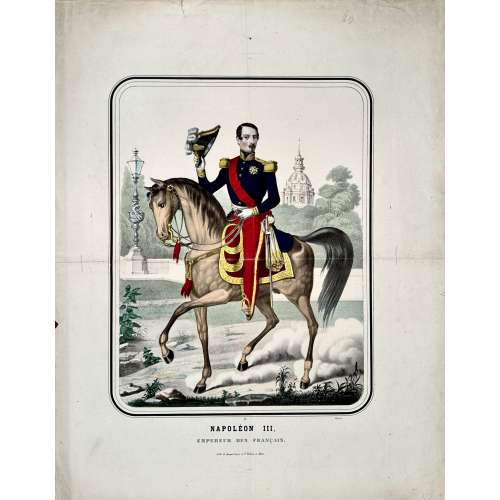 Hand-coloured chromolithography on wove paper, 600 x 470 mm; black ink stamp “4921” to reverse, horizontal and vertical centrefolds. Image of Napoléon III on horseback, in a frame; lettering under the frame: 34 — Déposé | NAPOLÉON III | EMPEREUR DES FRANÇAIS. | Lith. de Gangel frères et P. Didion, à Metz. || Gangel frères et P. Didion (Metz) – printer/publisher. Paulin Didion (French, 1831 – 1879)
Hand-coloured chromolithography on wove paper, 600 x 470 mm; black ink stamp “4921” to reverse, horizontal and vertical centrefolds. Image of Napoléon III on horseback, in a frame; lettering under the frame: 34 — Déposé | NAPOLÉON III | EMPEREUR DES FRANÇAIS. | Lith. de Gangel frères et P. Didion, à Metz. || Gangel frères et P. Didion (Metz) – printer/publisher. Paulin Didion (French, 1831 – 1879) -
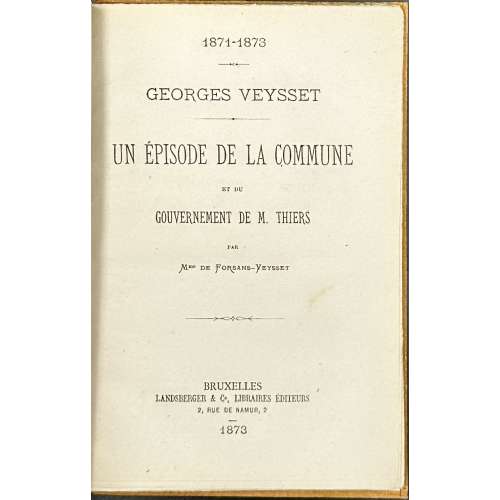 Owner’s hardcover, 182 x 120 mm, yellow buckram, crimson morocco label to spine with gilt lettering; publisher’s pink wrappers preserved, round engraved bookplate to front pastedown “DE LA BIBLIOTHÈQUE DE JULES RICHARD” cut to the border (“Imp. r. C. Motteroz” cut out); Pp.: [4] [1-5] 6-83 [84], various mss and printed clippings, 2 extra ffls to front and back. Title-page: 1871-1873 | — | GORGES VEYSSET | — | UN ÉPISODE DE LA COMMUNE | ET DU | GOUVERNEMENT DE M. THIERS | PAR | Mme DE FORSANS-YEYSSET | — | BRUXELLES | LANDSBERGER & C°, LIBRAIRES ÉDITEURS | 2, RUE DE NAMUR, 2 | 1873 || Provenance: Jules Richard (French, 1848 – 1930). Ref: BNF.
Owner’s hardcover, 182 x 120 mm, yellow buckram, crimson morocco label to spine with gilt lettering; publisher’s pink wrappers preserved, round engraved bookplate to front pastedown “DE LA BIBLIOTHÈQUE DE JULES RICHARD” cut to the border (“Imp. r. C. Motteroz” cut out); Pp.: [4] [1-5] 6-83 [84], various mss and printed clippings, 2 extra ffls to front and back. Title-page: 1871-1873 | — | GORGES VEYSSET | — | UN ÉPISODE DE LA COMMUNE | ET DU | GOUVERNEMENT DE M. THIERS | PAR | Mme DE FORSANS-YEYSSET | — | BRUXELLES | LANDSBERGER & C°, LIBRAIRES ÉDITEURS | 2, RUE DE NAMUR, 2 | 1873 || Provenance: Jules Richard (French, 1848 – 1930). Ref: BNF. -

Жуковский Ю. Г. Политические и общественные теории XVI-го века. - С.Петербург, 1866. Типография А. Головачева. // Материалы для общественной науки. - 163 с.
Схоластика.
Макиавелли и Томас Мор.
Реформация: Лютер, Кальвин, анабаптисты.
Жан Боден.
[Штамп на титуле: A. Namoradze, Tiflis. 1935.]
-
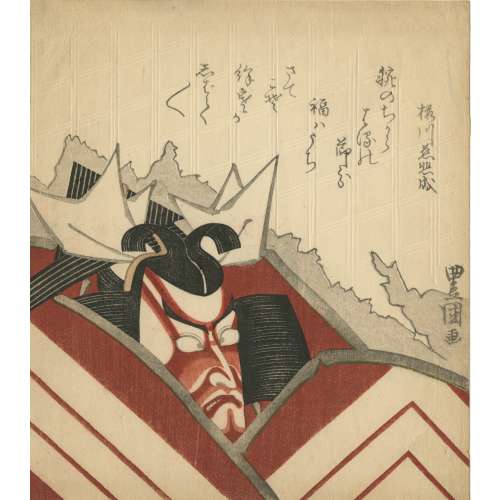 UTAGAWA TOYOKUNI I (1769–1825) Ichikawa Danjūrō VII (Ebizo V) in a shibaraku costume bursting through a paper screen. Surimono. Colour woodblock print: shikishiban, 8⅛ x 7⅛ in. (20.7 x 18.2 cm) Signed: Toyokuni ga Poem signed: Sakuragawa Jihinari Provenance: Sidney C. Ward
UTAGAWA TOYOKUNI I (1769–1825) Ichikawa Danjūrō VII (Ebizo V) in a shibaraku costume bursting through a paper screen. Surimono. Colour woodblock print: shikishiban, 8⅛ x 7⅛ in. (20.7 x 18.2 cm) Signed: Toyokuni ga Poem signed: Sakuragawa Jihinari Provenance: Sidney C. Ward -
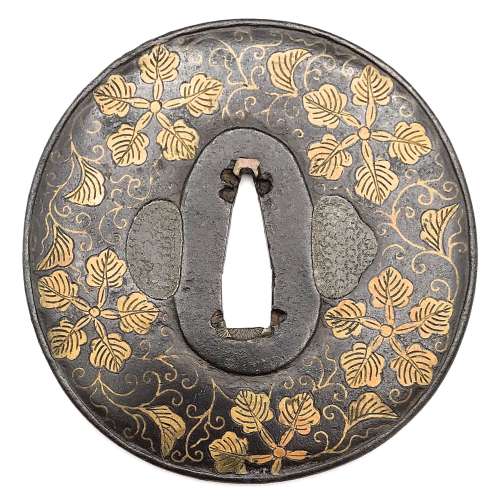 Iron tsuba of slightly elongated round form decorated with design of melon flowers, vines, and leaves in brass flat inlay (hira-zōgan) on both sides. Slightly raised rim (mimi) carved in a way to simulate ring-shaped covering (fukurin). Kozuka hitsu-ana and kogai hitsu-ana both plugged with soft metal (tim or lead). Copper sekigane. Heianjō or Kaga School. Muromachi or Momoyama period, 16th century. Iron, hira-zōgan brass inlay. Round (maru gata) form, diameter 79 mm. Size: 80.3 x 78.4 mm; thickness at seppa-dai: 3.4 mm; at the middle: 3.8 mm; before the rim: 2.4 mm, rim: 2.8 mm. Note on design: though this design resembles family crests with oak and mulberry leaves, I believe it's a melon flower [see Jeanne Allen. Designer's guide to Samurai Patterns. Chronicle Books, San Francisco, 1990, page 114, №130 "Melon Flowers":Note about the distribution of thickness (niku-oki): "this tsuba has toroid features, niku raises from the rim towards the centre but thins once more out when approaching the seppa-dai" [M. Sesko, "Handbook...", p. 48].
Iron tsuba of slightly elongated round form decorated with design of melon flowers, vines, and leaves in brass flat inlay (hira-zōgan) on both sides. Slightly raised rim (mimi) carved in a way to simulate ring-shaped covering (fukurin). Kozuka hitsu-ana and kogai hitsu-ana both plugged with soft metal (tim or lead). Copper sekigane. Heianjō or Kaga School. Muromachi or Momoyama period, 16th century. Iron, hira-zōgan brass inlay. Round (maru gata) form, diameter 79 mm. Size: 80.3 x 78.4 mm; thickness at seppa-dai: 3.4 mm; at the middle: 3.8 mm; before the rim: 2.4 mm, rim: 2.8 mm. Note on design: though this design resembles family crests with oak and mulberry leaves, I believe it's a melon flower [see Jeanne Allen. Designer's guide to Samurai Patterns. Chronicle Books, San Francisco, 1990, page 114, №130 "Melon Flowers":Note about the distribution of thickness (niku-oki): "this tsuba has toroid features, niku raises from the rim towards the centre but thins once more out when approaching the seppa-dai" [M. Sesko, "Handbook...", p. 48].
Jeanne Allen. Designer's guide to Samurai Patterns. Chronicle Books, San Francisco, 1990. Page 114, №130.
-
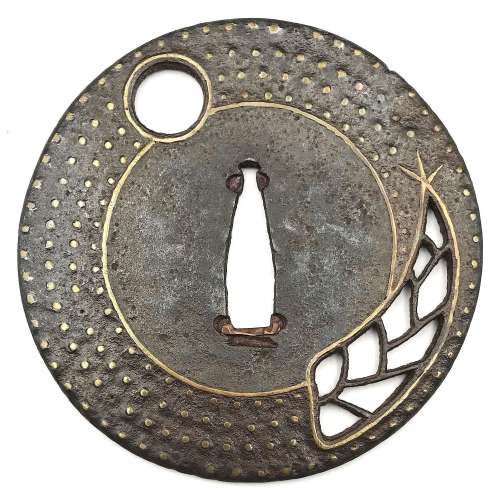 Ōnin shinchū ten-zōgan tsuba. Iron tsuba of round form decorated with full moon and bamboo shoot (takenoko) motif executed in openwork (sukashi) and inlaid with four concentric rows of brass dots (ten-zōgan). The innermost row of dots as well as the sukashi openings outlined with the inlaid linear brass wire. Late Muromachi period, 16th century. Diameter: 82.0 mm; Thickness: 2.8 mm Cited from Merrily Baird. Symbols of Japan. Thematic motifs in art and design. Rizzoli international publications, Inc., 2001, p. 72: "In Japanese art, the appearance of bamboo shoots is often without symbolic meaning. In other cases, however, the shoots are emblematic of Moso (Chinese: Meng Tsung/Meng Zong), a paragon of filial piety who dug through snow to find shoots for his mother. ... especially in miniature art forms, let bamboo shoots alone speak for the full story." The full story is this (See THE TWENTY-FOUR PARAGONS OF FILIAL PIETY [ERSHISI XIAO]):
Ōnin shinchū ten-zōgan tsuba. Iron tsuba of round form decorated with full moon and bamboo shoot (takenoko) motif executed in openwork (sukashi) and inlaid with four concentric rows of brass dots (ten-zōgan). The innermost row of dots as well as the sukashi openings outlined with the inlaid linear brass wire. Late Muromachi period, 16th century. Diameter: 82.0 mm; Thickness: 2.8 mm Cited from Merrily Baird. Symbols of Japan. Thematic motifs in art and design. Rizzoli international publications, Inc., 2001, p. 72: "In Japanese art, the appearance of bamboo shoots is often without symbolic meaning. In other cases, however, the shoots are emblematic of Moso (Chinese: Meng Tsung/Meng Zong), a paragon of filial piety who dug through snow to find shoots for his mother. ... especially in miniature art forms, let bamboo shoots alone speak for the full story." The full story is this (See THE TWENTY-FOUR PARAGONS OF FILIAL PIETY [ERSHISI XIAO]):Tears That Brought Bamboo-shoots From the Frozen Earth: Meng Zong Meng Zong lived during the Three Kingdoms Period of China's past. His father died when he was young, and he and his mother struggled to survive. One winter his mother was stricken with a serious illness, and craved some bamboo-shoot broth as medicine. But in the depths of winter, with snow and ice blanketing the ground, where was anyone to find fresh bamboo shoots, shoots that emerge only in the warm months? Nonetheless, Meng Zong, to avoid disappointing his mother, bravely fetched his shovel and went out into the white landscape in search of bamboo shoots. In the thicket he found only frosted leaves and green stalks coated with snowflakes and ice. Look as he might, there were simply no fresh shoots growing in the winter. The thought of his poor mother lying sick on her bed, waiting for bamboo-broth medicine, made his heartache. Uncontrollably, tears began to fall in rivers to the ground beneath the tall, emerald canes. Even now, as his tears flowed down, he kept a light of faith in his heart. If he was truly sincere in his search, perhaps.... Just then Meng Zong nearly tripped and fell over a sharply protruding lump of earth. He quickly knelt down and knocked aside the dirt with his trembling fingers. How uncanny! Underneath his frozen hands he discovered a bed of fresh, tender bamboo shoots! Overjoyed, he gathered up a coatful and carried them back home. The broth that he quickly set stewing in the pot soon cured his mother's illness. The neighbors, hearing the story, exclaimed that it was the strength of his sincere, unselfish, filial resolve that inspired heaven and earth to respond, and to bring up, out of season, the fresh shoots that cured his mother's disease. Before Meng Zong's prayers generated this miracle, it was normally considered impossible for bamboo shoots to grow in the winter. After the nmiracle took place, however, people were able to gather and to eat bamboo shoots all year round. The winter variety that existed hereafter became known as "winter shoots." The villagers were deeply influenced by Meng Zong's courage and devotion. They renamed the spot where the event took place, "Meng Zong's Bamboo Grove". We can now enjoy bamboo sprouts during the winter as well, and as we do so, it is fitting to recollect Meng Zong's outstanding example of filial respect, and reflect on our conduct as sons and daughter of our parents. A verse in his honor says, His teardrops transformed winter at the roots; Up from the ice crept tender bamboo shoots. Instantly, the winter-sprouts matured; Heaven's will: a happy, peaceful world.
-
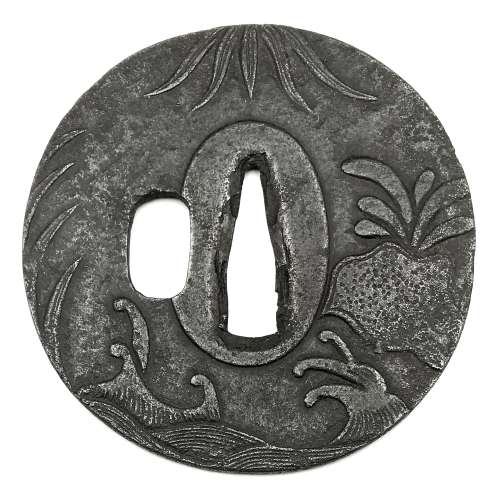 Round iron plate of grey colour decorated in low relief (sukidashi-bori) on the face with sea waves (both layered waves, seigaiha, and rough waves, araumi), sago palm (cycas revoluta, sotetsu), presumably orchid leaves (ran) - five of them - hanging from the above, and reeds (ashi), and on the back with waves (seigaiha only), rocks, chrysanthemums (kiku), clove (chori), reed, and presumably orchid leaves - three of them - hanging from the above. The kozuka-hitsu-ana was probably cut later. The plate is lacking the raised rim, typical for the kamakura-bori school. Muromachi period. Dimensions: Height: 76.8 mm, width: 76.1 mm, Thickness at seppa-dai: 3.3 mm, at rim 2.0 mm. Height of nakago-ana: 29 mm. Weight: 82.4 g. NBTHK certificate № 402152: Hozon - "Worthy of preservation". A similar (most probably the same) tsuba is illustrated and described at Butterfield & Butterfield. IMPORTANT JAPANESE SWORDS, SWORD FITTINGS AND ARMOR. Auction Monday, November 19th, 1979. Sale # 3063 under lot № 66. It describes the piece as following: “Kamakura bori work of the Muromachi period. Round thin plate with some small iron bones in the edge. Carved with design of plants (sego palm) rocks, and waves on the face. The back has half of two chrysanthemums, waves, clove, and sego palm leaves. The kozuka-hitsu has been added and later enlarged. A good typical example without the rim most have. Diameter: 7.7 cm., thickness 2.5 mm. Estimated price $100-200":
Round iron plate of grey colour decorated in low relief (sukidashi-bori) on the face with sea waves (both layered waves, seigaiha, and rough waves, araumi), sago palm (cycas revoluta, sotetsu), presumably orchid leaves (ran) - five of them - hanging from the above, and reeds (ashi), and on the back with waves (seigaiha only), rocks, chrysanthemums (kiku), clove (chori), reed, and presumably orchid leaves - three of them - hanging from the above. The kozuka-hitsu-ana was probably cut later. The plate is lacking the raised rim, typical for the kamakura-bori school. Muromachi period. Dimensions: Height: 76.8 mm, width: 76.1 mm, Thickness at seppa-dai: 3.3 mm, at rim 2.0 mm. Height of nakago-ana: 29 mm. Weight: 82.4 g. NBTHK certificate № 402152: Hozon - "Worthy of preservation". A similar (most probably the same) tsuba is illustrated and described at Butterfield & Butterfield. IMPORTANT JAPANESE SWORDS, SWORD FITTINGS AND ARMOR. Auction Monday, November 19th, 1979. Sale # 3063 under lot № 66. It describes the piece as following: “Kamakura bori work of the Muromachi period. Round thin plate with some small iron bones in the edge. Carved with design of plants (sego palm) rocks, and waves on the face. The back has half of two chrysanthemums, waves, clove, and sego palm leaves. The kozuka-hitsu has been added and later enlarged. A good typical example without the rim most have. Diameter: 7.7 cm., thickness 2.5 mm. Estimated price $100-200":
Butterfield & Butterfield, 1979. Sale # 3063, lot № 66.
-
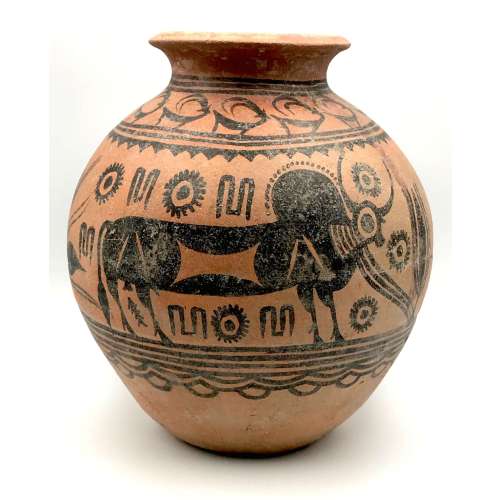 Circa 3300-2000 BC Dimensions: 184 x 165mm. Weight: 708grams
Circa 3300-2000 BC Dimensions: 184 x 165mm. Weight: 708grams -
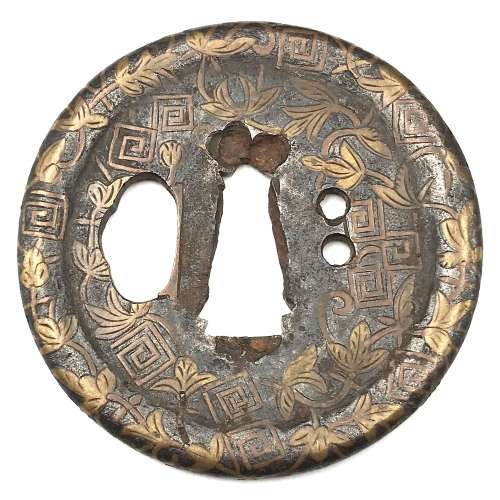
Iron tsuba of round form with dam-shaped rim (dote-mimi) pierced with hitsu-ana and two udenuki-ana (probably cut later on) decorated in flat inlay (hira-zōgan) with vines and symbols of thunder or lightning (possibly - family crest, mon). Hitsu-ana and nakago-ana with copper sekigane.
Ōnin or Heianjō school, or, possibly Kaga or Umetada school. Momoyama period or earlier (Muromachi), 16th century. Unsigned.Size: 64.5 x 63.8 x 2.2 (center), 4.2 (rim) mm.
Provenance: Lundgren Collection: [Japanese sword-fittings and metalwork in the Lundgren Collection. Published by Otsuka Kogeisha Co., Ltd., Tokyo 1992], №31; The Lundgren Collection of Japanese Swords, Sword Fittings and A Group of Miochin School Metalwork. Christie's Auction: Tuesday, 18 November 1997, London. Sales "GOTO-5881". Christie's, 1997, №2. Lundgren's description at Christie's: Heianjo tsuba. Unsigned. The circular plate decorated in brass hirazogan with flowers, plants and symbols of thunder, dote mimi and udenuki ana, late Muromachi period (16th century). Tokyo 1992 description: Sword guard with design of flowering plants and frets in inlay. Unsigned. Heianjo inlay school. 6.35 x 6.3 cm, thickness of rim 0.40 cm. Iron. Flat brass inlay. Muromachi-Momoyama Period, 16th century. Provenance: The Second John Harding. A somewhat look-a-like pieces can be found in various catalogues. The one in Naunton Collection, №172, is signed: Umetada of Yamashiro: "Iron, small, almost circular, with raised oval rim, inlaid all over with leaves and scrolls in brass hirazōgan." -
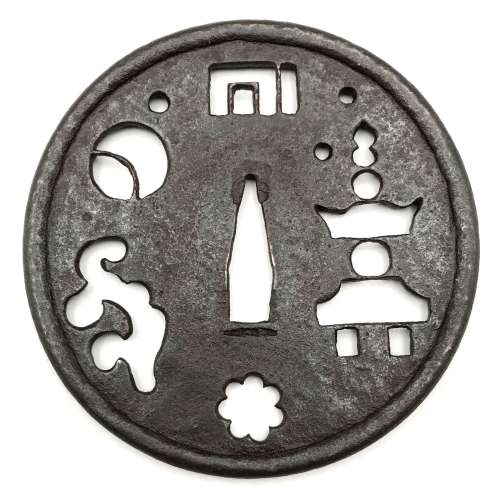 Iron tsuba of round form decorated with design of moon, stars, cloud, snowflake, gorintō, and Genji-mon in negative openwork (in-sukashi). Raised tubular rim (dote-mimi). Deep black patina, traces of lacquer. Naka-daka type of plate (thicker in center, getting thiner towards the rim). Visible gap between the rim and the plate. Dimensions: Height: 91.7 mm; Width: 90.8 mm; Thickness at seppa-dai: 2.5 mm, plate before rim: 2.2 mm, of the rim: 5.6 mm. At least Mid Muromachi period, 15th century, but possibly earlier. In 'Silver Book', commenting tsuba №34 Sasano writes: "The technique used to create the rim is the same used for the peak (koshimaki) of helmets (kabuto) during the Kamakura and Nanbokucho periods." On the other hand, the abundance of sukashi elements points towards later times, perhaps late Muromachi or even Momoyama period. "Gorintō is a grave stone composed of five pieces, piled on one the other, representing, from the bottom upward, earth, water, fire, wind, and heaven, respectively" [Nihon Tō Kōza, Volume VI, Part 1. AFU, 1993, p. 6. / LIB-1554]. A romantic description of the piece may look like this: The air is scented (incense symbol); it's a graveyard, marked by gorintō; a winter (snowflake) evening or night (moon, stars); mist is rising from a ravine towards moon. I did not manage to find a katchūshi piece of this design, only a few Kamakura-bori tsuba:
Iron tsuba of round form decorated with design of moon, stars, cloud, snowflake, gorintō, and Genji-mon in negative openwork (in-sukashi). Raised tubular rim (dote-mimi). Deep black patina, traces of lacquer. Naka-daka type of plate (thicker in center, getting thiner towards the rim). Visible gap between the rim and the plate. Dimensions: Height: 91.7 mm; Width: 90.8 mm; Thickness at seppa-dai: 2.5 mm, plate before rim: 2.2 mm, of the rim: 5.6 mm. At least Mid Muromachi period, 15th century, but possibly earlier. In 'Silver Book', commenting tsuba №34 Sasano writes: "The technique used to create the rim is the same used for the peak (koshimaki) of helmets (kabuto) during the Kamakura and Nanbokucho periods." On the other hand, the abundance of sukashi elements points towards later times, perhaps late Muromachi or even Momoyama period. "Gorintō is a grave stone composed of five pieces, piled on one the other, representing, from the bottom upward, earth, water, fire, wind, and heaven, respectively" [Nihon Tō Kōza, Volume VI, Part 1. AFU, 1993, p. 6. / LIB-1554]. A romantic description of the piece may look like this: The air is scented (incense symbol); it's a graveyard, marked by gorintō; a winter (snowflake) evening or night (moon, stars); mist is rising from a ravine towards moon. I did not manage to find a katchūshi piece of this design, only a few Kamakura-bori tsuba:
100 selected tsuba from European collections. Catalogue by Robert Haynes and Robert Burawoy, 1984, page 16, №5.
While the upper tsuba is dated end of Muromachi, the lower is attributed to the 17th century - Momoyama or early Edo period, though the author put this attribution under question. Deciphering of the strangely shaped opening to the left of nakago-ana is sometimes "a conventional scroll", and sometimes - a fern or bracken. I think mine is a cloud or mist, but I don't have any material evidence proving this understanding and came to conclusion by context only. It may easily be a dinosaurs playing ball. The fact that this thing always accompanies the Genji-mon, or incense symbol, it may be a scent itself.
Japanese Sword Fittings. Collection of G.H. Naunton, Esq., by Henri L. Joly, - 1912; №9.
-
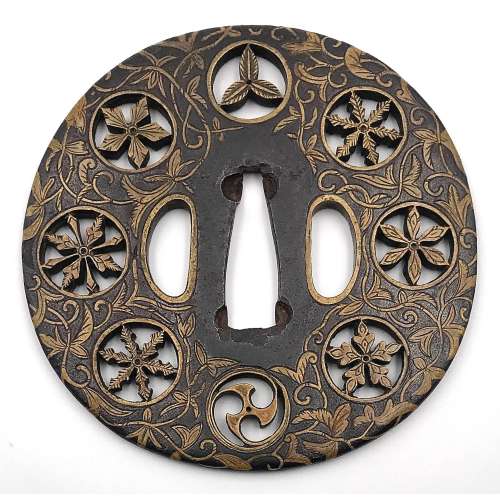 Iron tsuba of round form decorated with eight roundels – circular emblems of flowers and/or family crests (mon) made of cast brass, pierced and chiselled in kebori, and with flat brass inlay (hira-zōgan) of vines or leaves all over the plate. Both hitsu-ana trimmed with brass. Nakago-ana of trapezoidal form. A distinctive character of this tsuba is a mon at 6 hours depicting tomoe (comma). Yoshirō school (Kaga-Yoshirō). Attributed to Koike Yoshirō Naomasa himself. Unsigned. The Momoyama or early Edo period, end of the 16th to the first half of the 17th century (1574-1650). Size: Diameter 82.0 mm, thickness 3.8 mm at seppa-dai, 3.4 mm at rim.
Iron tsuba of round form decorated with eight roundels – circular emblems of flowers and/or family crests (mon) made of cast brass, pierced and chiselled in kebori, and with flat brass inlay (hira-zōgan) of vines or leaves all over the plate. Both hitsu-ana trimmed with brass. Nakago-ana of trapezoidal form. A distinctive character of this tsuba is a mon at 6 hours depicting tomoe (comma). Yoshirō school (Kaga-Yoshirō). Attributed to Koike Yoshirō Naomasa himself. Unsigned. The Momoyama or early Edo period, end of the 16th to the first half of the 17th century (1574-1650). Size: Diameter 82.0 mm, thickness 3.8 mm at seppa-dai, 3.4 mm at rim.


